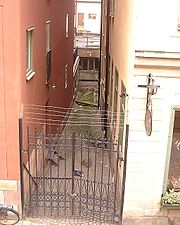
Fru Gunillas Gränd
Encyclopedia

Alley
An alley or alleyway is a narrow lane found in urban areas, often for pedestrians only, which usually runs between or behind buildings. In older cities and towns in Europe, alleys are often what is left of a medieval street network, or a right of way or ancient footpath in an urban setting...
in Gamla stan
Gamla stan
Gamla stan , until 1980 officially Staden mellan broarna , is the old town of Stockholm, Sweden. Gamla stan consists primarily of the island Stadsholmen. The surrounding islets Riddarholmen, Helgeandsholmen, and Strömsborg are officially part of, but not colloquially included in, Gamla stan...
, the old town in central Stockholm
Stockholm
Stockholm is the capital and the largest city of Sweden and constitutes the most populated urban area in Scandinavia. Stockholm is the most populous city in Sweden, with a population of 851,155 in the municipality , 1.37 million in the urban area , and around 2.1 million in the metropolitan area...
, Sweden
Sweden
Sweden , officially the Kingdom of Sweden , is a Nordic country on the Scandinavian Peninsula in Northern Europe. Sweden borders with Norway and Finland and is connected to Denmark by a bridge-tunnel across the Öresund....
, once connecting Skeppsbron
Skeppsbron
Skeppsbron is both a street and a quay in Gamla stan, the old town of Stockholm, capital of Sweden, stretching from the bridge Strömbron in front of the Royal Palace southward to Slussen....
to Österlånggatan
Österlånggatan
Österlånggatan is a street in Gamla stan, the old town of Stockholm, Sweden. Stretching southward from Slottsbacken to Järntorget, it forms a parallel street to Baggensgatan and Skeppsbron...
between Johannesgränd
Johannesgränd
Johannesgränd is an alley in Gamla stan, the old town of Stockholm, Sweden, connecting Skeppsbron to Österlånggatan....
and Packhusgränd
Packhusgränd
Packhusgränd is an alley in Gamla stan, the old town of Stockholm, Sweden. Stretching west from Skeppsbron to Österlånggatan, it forms a parallel street to Johannesgränd and Tullgränd....
.
In the old town, minor passages between properties, especially those located just outside of the old city wall, were often shut off by adjacent proprietors to be used as back-yards and filled with heaps of rubbish, and were frequently the subject for lengthy legal proceedings between proprietors and the city during the 17th century. While some of these alleys, such as Mårten Trotzigs Gränd
Mårten Trotzigs Gränd
Mårten Trotzigs gränd is an alley in Gamla stan, the old town of Stockholm, Sweden. Leading from Västerlånggatan and Järntorget up to Prästgatan and Tyska Stallplan, the width of its 36 steps tapers down to a mere 90 cm, making the alley the narrowest street in Stockholm.The alley is named...
, today the narrowest alley in the old town, was reopened in 1945, Fru Gunillas Gränd remains closed. During the 15th, 16th, and 17th centuries, it was open in both ends, thereafter closed off towards Skeppsbron, and, judging from its absence on a map dated 1733, then sealed off in both ends.
The alley was known as Doktor Belows gränd during the end of the 17th century, probably in reference to a major proprietor in the block constantly disputing the use of the alley with his neighbours. It is most likely the alley named Herr Henning Pinnows gränd ("Alley of Mr. Henning Pinnow") and Herr Måns Erikssons gränd ("Alley of Mr. Måns Eriksson") in the 15th century, the former known to have sold a house to the latter in 1472. In 1513, the alley was then named after Gunilla Johansdotter Bese (1473–1553), wife of Erik Turesson Bielke
Eric Bielke
Eric Bielke , also known as Eerikki Tuurenpoika and Eric Tureson, royal councillor of Sweden, knighted, feudal fiefholder of Vyborg castle .-Biography:...
(-1511) and mother to the grandfather of Queen Gunilla Bielke
Gunilla Bielke
Gunilla Bielke; full name: Gunilla Johansdotter Bielke , was Queen of Sweden, the second spouse and queen consort of king John III of Sweden...
(1568–1597), and in 1674 the alley was even referred to as Sancta Gunillas gränd ("Alley of St Gunilla").

